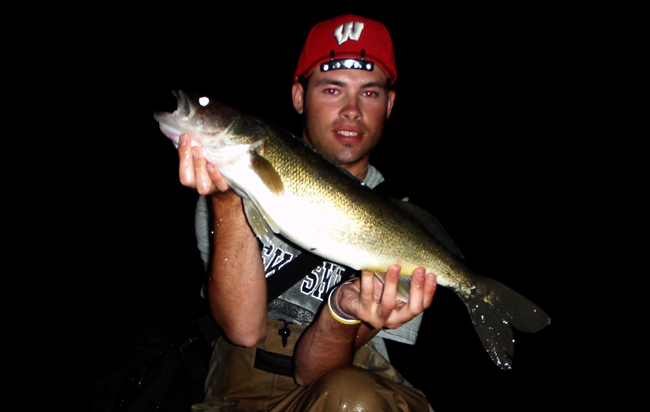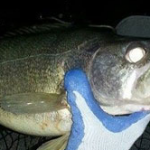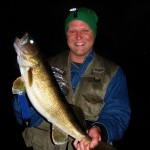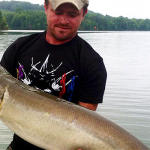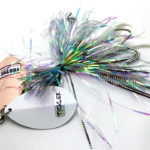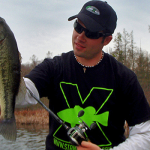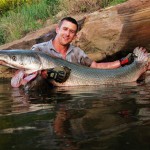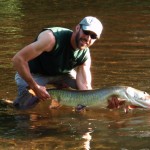By: Andrew Ragas – Date Posted: July 10, 2012
Daytime fishing for walleyes on your nearest river system during the warm summer months often means seeking out the deepest pools you can access, long hours of patiently waiting for fish to bite, and excessive sun burns. In all my years of fishing rivers for walleyes, I have come to learn that the daytime hours are best spent by working on the day-job and living a normal lifestyle, while the evening and nighttime hours following sunset should, without question, be reserved for fishing.
Most walleye fishermen usually associate the nighttime hours with both the spring and fall seasonal periods as fish are in the midst of their runs, present in more concentrated numbers, and are most vulnerable to be caught by waders at night. During these periods water temperatures are colder which offers more successful fishing and a predictable feed. However, nighttime fishing for walleyes during the summer can be just as good as fish will always take advantage of the dark to feed.

I first discovered the mystique of nighttime wading for river walleyes during the summer of 2006. I recall it was hot and humid which also brought some occasional rainfall that greatly helped our Midwestern rivers. Due to the daily temperatures reaching averages of 85 to 100 degrees, daytime angling was not in my best interests. Looking back it seems as if both the fish and I avoided the sunlight together at the same times and then enjoyed each other’s company at night. Since then I have enjoyed tremendous nighttime success and it is my preferred way to fish for walleyes during summer.

Walleyes are cool water species that are most active in low light conditions. The daytime hours of summer are usually the off-time for walleyes. In lower Midwestern regions such as Illinois, warm weather and humidity persists throughout much of summer. The same can also be noted for the walleye factory states such as Wisconsin, Minnesota, and the Dakota’s. This all correlates with bright sunlight that consequently brings warm water temperatures that usually average anywhere from 75 to 85 degrees. Sometimes, the rivers and streams around my neck of the cornfield in Northern Illinois can get up to 90 degrees during the hottest days which are excruciatingly hot.
Despite the hot days and warm water temperatures, everything comes out as soon as the sun begins to set. Both walleyes and prey fish species emerge to feed, and become the most active unlike at any other point of the day.

Beating the Heat
Most of the major river systems throughout the Midwest contain fishable populations of walleyes as they are either sustained naturally or receive stockings to supplement the fisheries. Despite stockings, I have found that certain river types fish better than others and offer more wading options.
In order to determine the walleye fishability of your river, there are a few things to keep in mind. Some factors to consider are depth, bottom composition, current flow rates, water clarity, and wade access to the good spots.
For nighttime wading, the best walleye rivers I’ve fished are shallower, hard-bottomed with rocks and mid-gradient current, with depths and pools varying from 3 to 6 ft., and moderate clarity of up to 2 ft. Some rivers I have fished throughout the Midwest that possess these great qualities are the Wisconsin River and its wade accessed dam areas (its Central and Northern stretches), the Des Plaines River and its larger tributaries, and the Fox and Kankakee Rivers – all three are located in Northeastern Illinois. There are definitely plenty more rivers in the Midwest I’ve never fished, that contain fine fisheries themselves, including some that are potentially world class.
Since wading is my preferred method, on the water safety and knowledge of location and presence of deep holes and underwater hazards is a priority. For these reasons it is best to scout your areas during the daytime because access areas and likely fish holding areas will be located without much trouble.

Summertime Locations
During summer, most walleyes will be relating to mid-river areas that have current and depth. These areas attract forage fish and contain higher levels of dissolved oxygen which reduces water temperatures by a few degrees. Specific areas I like to concentrate on are gravel bars that protrude from shore and extend out towards the main channel areas. These places are most likely to contain fish throughout the season as they have depth and form current, and are easily accessed by wading from the shallow upstream sides and casting directly into the deeper pools downstream. Other areas worth spending time at are the end pools and deep holes of rock and riffle runs, and downstream pools of dams. Last but not least, bottom transitions from mud and sand to rock and even wood will also attract fish providing that depth is greater than 3 ft. It is important to note that all of these preferred areas I target will have depths anywhere from 3 to 6 ft., hard bottom with moderate current, and in all likelihood contain walleyes.
Besides habitat and river locations, moon phase plays a tremendous influence in my success of nighttime angling. As recorded in my logbook since 2006, approximately 75% of all my nighttime walleyes throughout the seasons have been caught while wading during the first quarter and full moon periods. In addition, most catches have taken place within the first two hours following sunset. The long extended periods of light brought forth by the moon prolongs fish feeding activity and stimulates nighttime migrations. Although the presence of moon rarely dictates whether or not to fish, it is interesting to point out how I have caught more fish while the moon has been visible and there has been an obvious transition from daytime sunlight to nighttime moonlight.

Minnow Moves
When fishing at night, I exclusively fish with medium sized minnow baits. Preferred sizes are 3 to 5 in. and some favorites are the F9 Floating Rapala, Shallow Shad Rap, and the XR8 Rapala X-Rap. Color choices don’t seem to matter but in some scenarios matching the hatch is critical, especially when there is a high presence and concentration of baitfish, and if the river has great water clarity. In these circumstances I use natural colors such as black/silvers, black/golds, purpledescents, whites, and yellow perch. However, when colors don’t make any difference I have caught fish on unnatural colors such as hot oranges, yellows, and even pinks. Sometimes it pays to experiment.

With minnowbaits it is important to make long casts. Retrieve the lure at a steady pace so that vibration and wobble is maximized, and the bait can be seen passing by fish. By doing so, fish will be triggered to strike.
Besides the old reliable minnowbait, I have also caught fish on jig and plastics and smaller swimbaits. However, I tend to put all plastics on reserve and tinker with them until the fall when fish grow conditioned and are prone to be responsive to more offerings.
As far as summertime gear is concerned, I tend to use lighter rods and reels that offer both power and sensitivity. Adequate gear is a 6 ft. 6 in. medium power, fast action spinning rod with a reel that can hold 6 and 8 lb. copolymer line. I use size 20 Quantum Catalysts that are spooled with 6 lb. Cortland Endurance, which is an abrasive-resistant and smooth-casting monofilament line. The gear I use is better suited for lighter applications such as jigging and swimming with plastics. With the lighter line I am able to cast for distance, and in several situations I fish in minimal snag areas that have nothing but open water current and a hard bottom with depth. The only instances in which I would use heavier tackle, such as a 7 foot rod of similar action with 8 lb. line, would be in the fall when fish are running in concentrated numbers, if fishing a larger section of river, and obviously when bigger fish are more readily available.
Ever since I began fishing for 100 degree walleyes in June 2006, I have enjoyed catching several walleyes from a variety of Midwestern rivers. My largest nighttime walleyes in summer to date have been a good half dozen that have fallen in the range of 24 to 27 inches. Do the math. . . . these fish weigh a good 4 to 6 lbs. Imagine how much bigger and fatter they could be in the fall, and perhaps during the spring spawn!
With all being said, forget about fishing during the daytime for summer river ‘eyes as they will be hiding and in negative moods. Your only reward will be sunburn and sweat. It’s night-time, or no-time. Apply these facts to your home waters and I guarantee you will enjoy the same success as I have had over the course of the last five summers.



